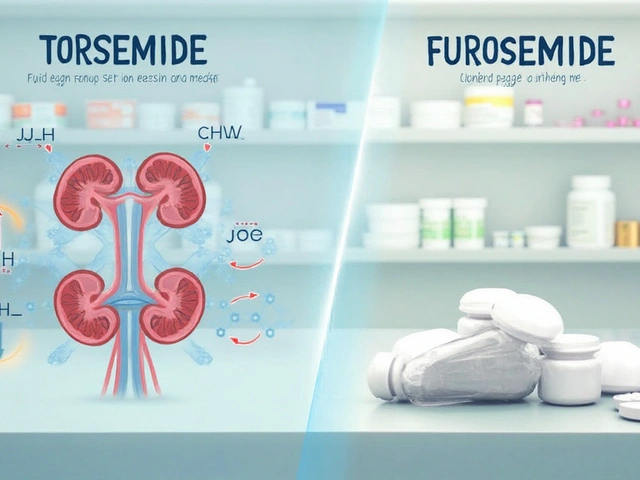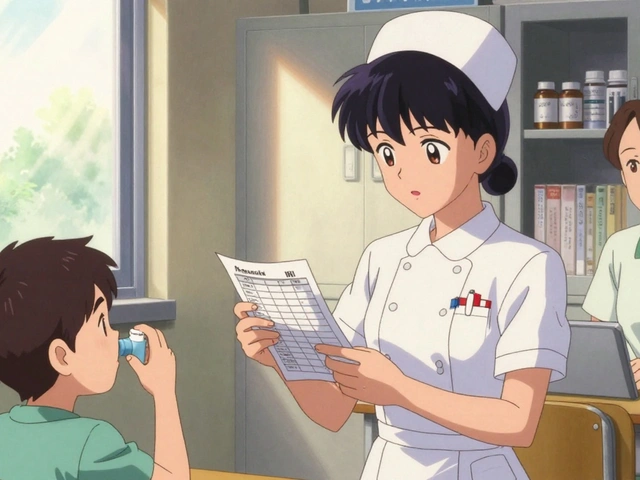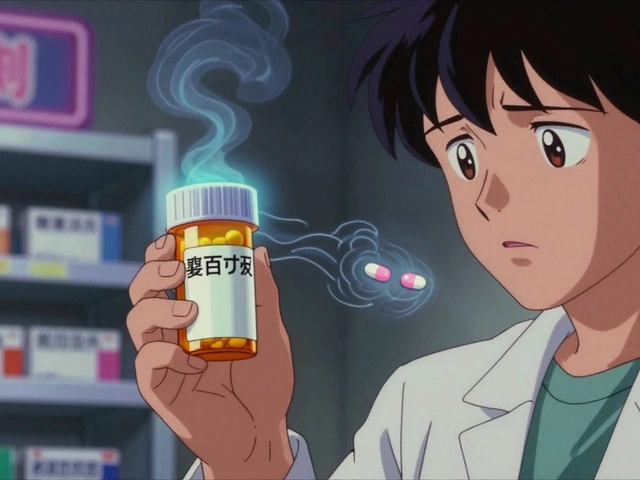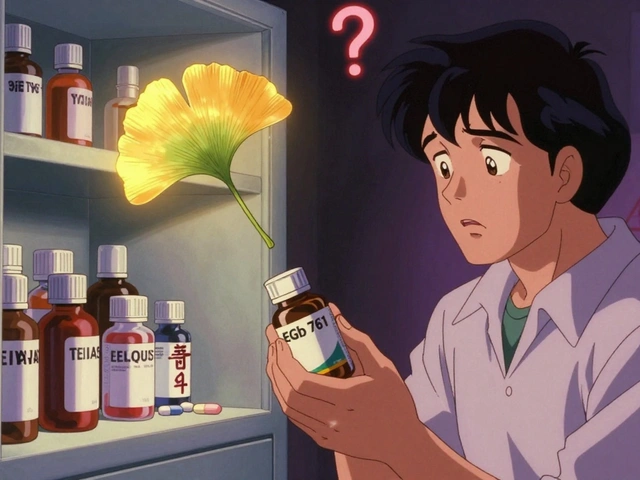MAOI Cold Medicine Safety Checker
This tool checks if over-the-counter cold medicines are safe to use with MAOIs (monoamine oxidase inhibitors). MAOIs are antidepressants that can cause life-threatening interactions with certain cold medications. Never use a cold medicine without verifying its safety with your doctor or pharmacist.
Important Safety Information
Most OTC cold medicines contain dangerous ingredients like pseudoephedrine, phenylephrine, or dextromethorphan. 78% of cold medicines contain at least one dangerous ingredient. Never assume a product is safe just because it's labeled "non-drowsy" or "natural." Always check with your pharmacist.
If you’re taking an MAOI for depression, even a simple cold remedy could send you to the emergency room. This isn’t a rare scare - it’s a well-documented, life-threatening risk that many patients don’t know about until it’s too late.
What Are MAOIs and Why Do They Matter?
MAOIs, or monoamine oxidase inhibitors, are antidepressants like phenelzine (Nardil), tranylcypromine (Parnate), and isocarboxazid (Marplan). They work by stopping the enzyme that breaks down brain chemicals like serotonin, norepinephrine, and dopamine. This helps lift mood in people who haven’t responded to other antidepressants. But that same mechanism makes them dangerous when mixed with common over-the-counter drugs.
Even the transdermal patch form, selegiline (Emsam), carries the same risks at higher doses. Though it’s become more popular - making up 68% of MAOI prescriptions in 2022 - it doesn’t make these interactions safer. The FDA still requires black box warnings on all MAOI packaging about dangerous interactions with cold medicines.
The Two Deadly Risks: Hypertensive Crisis and Serotonin Syndrome
There are two main dangers when MAOIs meet OTC cold meds: hypertensive crisis and serotonin syndrome. Both can kill.
Hypertensive crisis happens when you take a decongestant like pseudoephedrine (found in Sudafed) or phenylephrine (Sudafed PE). These drugs trigger a surge of norepinephrine. Normally, your body breaks it down quickly. But MAOIs block that process. The result? Blood pressure can spike to 220/110 mmHg or higher. One Reddit user reported this exact scenario after taking Sudafed with Parnate. They ended up in the ER with a hypertensive emergency.
Serotonin syndrome occurs when you combine MAOIs with serotonergic drugs like dextromethorphan (found in Robitussin DM, Delsym, and DayQuil). Both increase serotonin levels. When they stack up, your nervous system goes into overdrive. Symptoms include confusion, rapid heart rate, high fever, muscle rigidity, and seizures. According to StatPearls, this combination is the most toxic known trigger for serotonin syndrome.
The FDA’s 1976 expert panel warned about these risks decades ago. And yet, people still mix them. Between 2018 and 2022, 127 cases of hypertensive crisis linked to MAOIs and OTC cold meds were reported to the FDA’s database. Eighteen of those required hospitalization.
What OTC Cold Medicines Are Dangerous?
You can’t just read the front of the bottle. Most cold and flu products are multi-symptom formulas. Here’s what to avoid:
- Pseudoephedrine - Sudafed, Claritin-D, Zyrtec-D
- Phenylephrine - Sudafed PE, Benadryl Allergy & Sinus, Mucinex D
- Dextromethorphan - Robitussin DM, Delsym, DayQuil, NyQuil, Theraflu
- Phenylpropanolamine - Older cold products (banned in the U.S. since 2000, but still found in some imported or older stock)
Here’s the catch: 78% of OTC cold medicines contain at least one of these ingredients. That means most cough syrups, sinus tablets, and nighttime cold remedies are off-limits.

What Can You Safely Take Instead?
You don’t have to suffer through a cold untreated. Safe alternatives exist:
- For cough: Guaifenesin (Mucinex) - breaks up mucus, no interaction risk.
- For fever or pain: Acetaminophen (Tylenol) - safe at standard doses.
- For runny nose or sneezing: Antihistamines like loratadine (Claritin) or cetirizine (Zyrtec) - these don’t trigger hypertensive crisis.
- For congestion: Saline nasal spray or steam inhalation - no drugs needed.
Always check the active ingredients. If it says “Multi-Symptom,” “Cold & Flu,” or “Nighttime,” skip it. Stick to single-ingredient products and verify them with your pharmacist.
Why Do People Still Get This Wrong?
It’s not just ignorance. It’s convenience. Cold medicine is everywhere - pharmacy shelves, gas stations, grocery stores. Labels are confusing. “Non-drowsy” doesn’t mean “safe with MAOIs.” “Natural” doesn’t mean “risk-free.”
One patient on PatientsLikeMe shared that their psychiatrist gave them a wallet-sized card listing every forbidden OTC drug. They’ve used it for five years and avoided every potential interaction. That’s the gold standard.
Most doctors don’t have time to explain this in detail. Pharmacists are your best ally. A 2021 University of North Carolina study found patients need 3 to 5 conversations with a pharmacist to fully understand the risks. Don’t assume your pharmacist knows - ask specifically: “Is this safe with MAOIs?”
What About Switching Medications?
If you’re thinking of switching from an MAOI to something like an SSRI or SNRI, don’t just stop one and start the other. The American Psychiatric Association recommends a 14-day washout period. Why? Because MAOIs bind irreversibly to enzymes. Your body needs weeks to make new ones. Jumping straight to another antidepressant can trigger serotonin syndrome.
The same rule applies in reverse. If you’re on an SSRI and want to start an MAOI, wait at least two weeks after stopping the SSRI. Fluoxetine (Prozac) sticks around even longer - you may need five weeks.

What’s Changing in the Future?
MAOIs are rare today - less than 1% of antidepressant prescriptions in the U.S. But they’re not going away. For treatment-resistant depression, response rates can exceed 50%, compared to 30-40% for SSRIs. That’s why specialists still prescribe them.
Research is underway for new versions. A reversible MAO-A inhibitor called CX-1010 is in Phase II trials (NCT04567812). If it works, it could reduce interaction risks while keeping the benefits. But it’s still years away.
For now, the safest path is clear: know your meds, ask your pharmacist, and avoid anything with pseudoephedrine, phenylephrine, or dextromethorphan.
What If You Accidentally Take One?
If you’ve taken a decongestant or cough syrup with your MAOI and feel:
- Severe headache
- Neck stiffness
- Blurred vision
- Rapid heartbeat
- Confusion or agitation
Call emergency services immediately. Don’t wait. Hypertensive crisis can cause stroke, heart attack, or organ failure within hours. Serotonin syndrome can be fatal if not treated fast.
Bring your medication list with you. Tell the ER staff you’re on an MAOI. That single piece of information can save your life.
Bottom Line
MAOIs work. But they demand respect. You can’t treat a cold the same way someone on an SSRI can. What’s safe for one person could be deadly for you. There’s no middle ground. No “just one pill.” No “I’ve never had a problem before.”
Keep a list of safe and unsafe OTC drugs. Use it every time you shop. Talk to your pharmacist - not just once, but every time you buy something new. And if you’re unsure, skip it. There’s always a safe alternative.
Your depression treatment is worth protecting. So is your life.
Can I take Tylenol with MAOIs?
Yes, acetaminophen (Tylenol) is safe to use with MAOIs for pain or fever. It doesn’t affect serotonin or norepinephrine levels and has no known dangerous interactions. Stick to the recommended dose - no more than 3,000 mg per day - and avoid combination products that include decongestants or dextromethorphan.
Is Sudafed PE safe with MAOIs?
No, Sudafed PE contains phenylephrine, which can cause a dangerous hypertensive crisis when taken with MAOIs. Even though it replaced pseudoephedrine in many products, phenylephrine still triggers the same risk. Avoid all versions of Sudafed, including the PE label.
Can I use nasal sprays with MAOIs?
Most topical nasal sprays like oxymetazoline (Afrin) are safer than oral decongestants because they’re absorbed in smaller amounts. But even these carry some risk if used for more than three days or in high doses. Saline sprays are the safest option. Always check with your pharmacist before using any nasal spray.
What if I’m on the selegiline patch (Emsam)?
Even at low doses (6 mg/24hr), the Emsam patch still carries the same interaction risks as oral MAOIs. While dietary tyramine restrictions are relaxed at this dose, OTC cold medicines with pseudoephedrine, phenylephrine, or dextromethorphan remain dangerous. Don’t assume the patch is safer - the drug interaction rules are unchanged.
How long do I have to wait after stopping an MAOI to take cold medicine?
Wait at least two weeks after stopping an MAOI before taking any decongestant or dextromethorphan. For irreversible MAOIs like phenelzine or tranylcypromine, this is critical because the enzyme inhibition lasts weeks. Even after you stop the drug, your body needs time to replace the blocked enzymes. Rushing this can still trigger a crisis.
Are herbal cold remedies safe with MAOIs?
Many herbal products contain hidden stimulants or serotonergic compounds. St. John’s Wort, ephedra (ma huang), and yohimbine are especially dangerous. Even common herbs like ginseng or guarana can raise blood pressure. There’s no reliable safety data for most herbal cold remedies with MAOIs. Stick to FDA-approved single-ingredient OTC drugs and avoid supplements entirely.
Can my pharmacist check my OTC meds for safety?
Yes - and you should ask them to. Pharmacists are trained to spot dangerous drug interactions. Bring your MAOI prescription and the OTC product you’re considering. Ask: “Is this safe with phenelzine (or your specific MAOI)?” Don’t rely on online lists alone - ingredients change, and labels can be misleading. A pharmacist’s verification is your best protection.
Every year, people on MAOIs end up in the ER because they didn’t know a cold medicine could kill them. It doesn’t have to be you. Know your meds. Ask questions. Choose safety over convenience.









15 Comments
Rodney Keats
Nov 17 2025So let me get this straight - I can’t take NyQuil, but I can take Tylenol? Cool. So my cold is now a 12-step program where the first step is ‘don’t die.’ Thanks, medicine. 🤡
Laura-Jade Vaughan
Nov 18 2025OMG this is so important 💔 I literally cried reading this. Like, imagine being told you can’t have a cold remedy because your brain is ‘too sensitive’? It’s like your depression makes you a liability in CVS. 🫂 #MAOILife #PharmaceuticalApartheid
Jennifer Stephenson
Nov 20 2025Acetaminophen is safe. Avoid decongestants. Talk to your pharmacist. Simple.
Segun Kareem
Nov 20 2025This is not just about medicine - it’s about dignity. When your body becomes a minefield just because you’re trying to feel human again, you learn to move through the world like a ghost. But you’re not alone. We’re all walking these tightropes. Stay safe, stay aware. You’re doing better than you think.
Philip Rindom
Nov 21 2025Y’all know the real MVP here is the pharmacist, right? Like, I once walked in with a bottle of DayQuil and asked, ‘Is this gonna kill me?’ They looked at me like I was their favorite person. 😅 Seriously though - pharmacists are the unsung heroes of mental health. Don’t be shy. Ask them. They’ve seen it all.
Jess Redfearn
Nov 23 2025Wait so I can’t take anything? What if I just take half a pill? Like, how bad can it be? I’ve done worse.
Ashley B
Nov 24 2025THIS IS A PHARMA CONSPIRACY. They want you dependent on ‘safe’ meds so they can keep selling you $80 bottles of guaifenesin. They banned phenylpropanolamine because it was too effective - now you’re stuck with saline sprays and ‘natural’ remedies that do nothing. Wake up. The system wants you weak.
Scott Walker
Nov 26 2025Just wanted to say thank you for writing this. I’ve been on Parnate for 3 years. This is the first time I’ve seen it explained so clearly. 🙏 I keep a printed list in my wallet now. No more guessing. Peace out, cold season.
Sharon Campbell
Nov 28 2025idk why people make such a big deal. i just take whatever. i’ve had colds for 20 years and still here. maybe the real problem is being on maos in the first place??
sara styles
Nov 29 2025Let me break this down for you like you’re five: MAOIs are ancient, dangerous, and should’ve been banned in 1987. The fact that doctors still prescribe them is a crime. And now they’re telling you not to take Sudafed? Newsflash: Sudafed is the ONLY thing that works for my sinuses. The rest is placebo nonsense. The FDA is a puppet of Big Pharma. They don’t care if you’re miserable - they care about profit. I’ve researched this for 47 hours. I’ve read every study. You’re being manipulated. This isn’t safety - it’s control. And don’t even get me started on ‘saline spray’ - that’s a joke. A $3 joke. You’re being gaslit into accepting mediocrity.
Brendan Peterson
Nov 30 2025There’s a nuance here that’s being overlooked. The risk profile of selegiline transdermal at 6 mg/24hr is significantly lower than oral MAOIs for decongestants - the pharmacokinetics are different. While the warning is still valid, the actual incidence of crisis is orders of magnitude lower. Most guidelines are written for phenelzine, not Emsam. That’s not being clarified enough.
Jessica M
Dec 1 2025As a clinical pharmacist with 18 years of experience, I cannot overstate the importance of this information. Every day, I see patients who have taken dextromethorphan with MAOIs and arrived in the ER confused, tachycardic, and terrified. These reactions are preventable. The safest approach is always: 1) Check every active ingredient. 2) Use single-ingredient products. 3) Consult your pharmacist before purchase. 4) Keep a printed list. 5) Never assume ‘non-drowsy’ means ‘safe.’ Your life is worth this diligence.
Vera Wayne
Dec 1 2025This is such a vital reminder - thank you for taking the time to lay this out so clearly. I’ve had friends who didn’t know the risks and nearly lost everything. Please, if you’re on an MAOI, share this with someone who needs to see it. We’re not being dramatic - we’re being alive. 💛
Erika Lukacs
Dec 2 2025It’s fascinating how the medicalization of everyday discomfort reveals our cultural aversion to vulnerability. We treat colds as emergencies because we’ve lost the capacity to endure minor suffering - and now, our antidepressants demand that we also surrender our access to over-the-counter relief. Is this healing, or is it control disguised as care?
Rebekah Kryger
Dec 3 2025Let’s be real - MAOIs are the opioid of psychotropics. They’re powerful, they’re addictive to the brain, and they come with a mountain of baggage. The fact that we’re still using them in 2025 is a sign that we haven’t evolved beyond trial-and-error psychiatry. We need better tools. Until then, yeah, avoid the cold meds. But also - question why we’re still stuck with this 1950s tech.